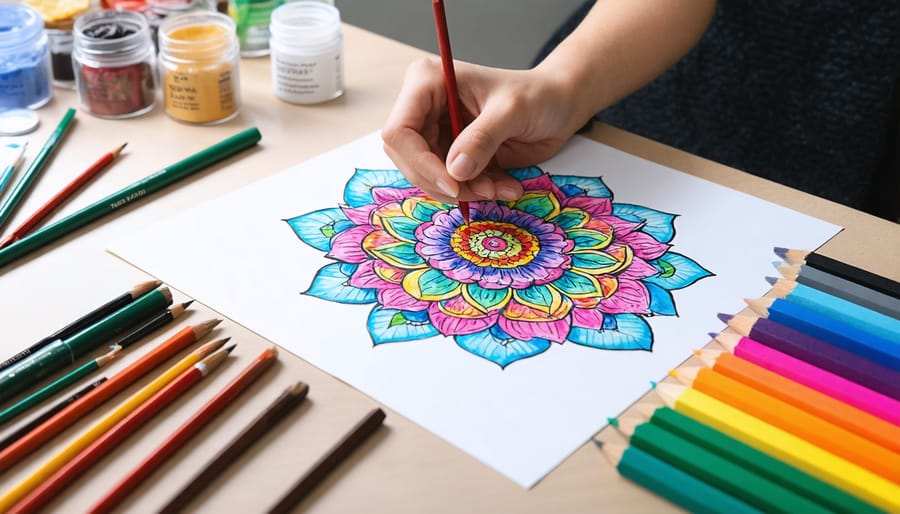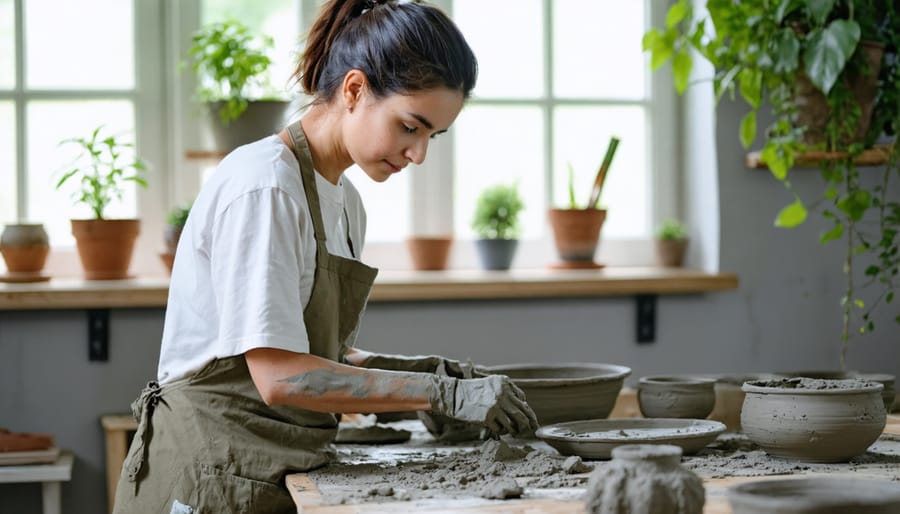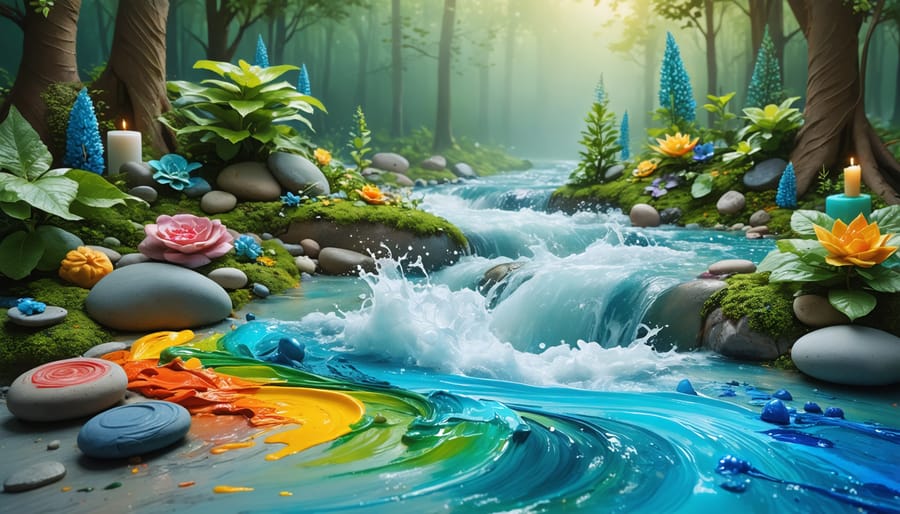Transform everyday emotions into powerful visual expressions through art therapy – a scientifically-backed approach that combines creative expression with mental wellness. Drawing, painting, or sculpting activates both hemispheres of your brain, releasing stress and anxiety while building emotional resilience. Whether you’re managing daily stress, processing trauma, or seeking personal growth, art therapy offers accessible tools that work without requiring artistic skill.
Local Alberta art therapists guide participants through structured creative exercises that help identify, express, and process complex feelings. Simple techniques like color meditation, where you choose colors that match your emotional state, or mindful mark-making, where you let your hand move freely across paper while focusing on your breath, create immediate paths to emotional release. These methods have shown measurable improvements in anxiety reduction, self-awareness, and emotional regulation across diverse age groups and conditions.
Start your art therapy journey with basic supplies – paper, colored pencils, and modeling clay – and experiment with different mediums to discover what resonates with you. The goal isn’t to create masterpieces but to engage in a therapeutic process that promotes healing and self-discovery through creative expression.
How Art Therapy Calms Your Mind and Body
The Science Behind Creative Expression
When you engage in creative expression, your brain undergoes fascinating changes that contribute to stress reduction and emotional well-being. Research shows that art-making activities trigger the release of dopamine, our body’s natural feel-good chemical, while simultaneously lowering cortisol levels, our primary stress hormone. This combination creates a natural calming effect, similar to what we see with other holistic therapy benefits.
During artistic activities, both hemispheres of your brain work together, creating new neural pathways that enhance problem-solving abilities and emotional processing. The rhythmic movements involved in drawing, painting, or sculpting can induce a meditative state, activating your parasympathetic nervous system – your body’s natural relaxation response.
Color interaction during art-making also plays a significant role. Blues and greens have been shown to promote calmness, while warmer colors like red and yellow can energize and stimulate creativity. This natural response to color helps explain why even simple coloring activities can reduce anxiety and improve mood.
Mental Health Benefits You Can Experience
Engaging in art therapy can bring about significant improvements in your mental well-being. Many participants report reduced anxiety levels after just a few sessions, finding that the simple act of creating art helps quiet racing thoughts and promotes a sense of calm. When you’re focused on painting, drawing, or sculpting, your mind naturally shifts away from worry and stress.
For those managing depression, art therapy offers a powerful outlet for self-expression. Creating art releases dopamine, your brain’s “feel-good” chemical, while providing a healthy way to process difficult emotions. You might find it easier to express feelings through colors and shapes when words feel inadequate.
Art therapy also strengthens emotional regulation skills. As you work through creative projects, you’ll develop better patience, flexibility, and resilience. Many people discover they can better handle daily stressors after incorporating regular art practice into their routines.
The benefits often extend beyond therapy sessions. You may notice improved sleep quality, enhanced self-awareness, and stronger social connections as you share your creative journey with others. These positive changes can create a ripple effect, supporting your overall mental health and daily functioning.
Simple Art Therapy Techniques You Can Try Today

Mindful Mandala Drawing
Creating mandalas is a meditative art practice that combines geometric patterns with mindful focus. Start by sitting in a quiet space with paper and your chosen drawing tools – colored pencils, markers, or fine-tipped pens work well. Begin at the center of your paper with a small circle or dot, then work outward in a circular motion, adding shapes, patterns, and designs that feel meaningful to you.
As you draw, focus on your breath and let your creativity flow naturally. There’s no right or wrong way to create a mandala – each one is unique to the artist and the moment. The repetitive nature of drawing circular patterns helps quiet the mind and reduce stress, while the creative process encourages self-expression and emotional release.
Many people find that regular mandala drawing helps improve concentration, reduces anxiety, and provides a sense of accomplishment. It’s particularly helpful during times of stress or when you need to center yourself. Try setting aside 15-20 minutes daily for this practice, and notice how your mandalas evolve as you become more comfortable with the technique.
Remember to date your mandalas and consider keeping notes about your feelings while creating them – this can provide valuable insights into your emotional journey over time.

Emotion Color Mapping
Color plays a powerful role in expressing and understanding our emotions. In art therapy, color mapping helps you connect with feelings that might be difficult to put into words. This technique involves choosing colors that resonate with your current emotional state and using them in your artwork.
For example, while red often represents anger or passion, and blue might symbolize calmness or sadness, your personal color associations may differ. There’s no “right” or “wrong” way to match colors with emotions – what matters is what each color means to you.
Try this simple exercise: Create a personal emotion wheel by drawing a circle and dividing it into sections. Fill each section with a color that represents different feelings you experience. Use this as a reference for future art projects or as a tool for tracking your emotional journey.
When working with colors, pay attention to which ones you’re naturally drawn to and which ones you avoid. These preferences often reveal insights about your emotional state. Remember to stay curious and non-judgmental about your color choices – they’re all valid expressions of your inner experience.
Stress-Relief Sculpting
Working with clay or playdough isn’t just for kids – it’s one of several proven stress reduction techniques that can help calm your mind and ease anxiety. The repetitive motions of kneading, rolling, and shaping clay engage your hands and focus your attention away from worrying thoughts.
Start with a baseball-sized piece of clay or playdough at room temperature. Find a comfortable spot at your table and simply begin exploring the material. There’s no need to create anything specific – focus on how the clay feels in your hands and how it responds to different pressures and movements.
Try simple exercises like creating smooth balls, rolling snakes, or pressing textures into the surface. When stress or anxiety builds up, channel that energy into squeezing or pounding the clay. Many Albertans find this particularly helpful during our long winters when indoor activities become essential for wellbeing.
Keep your clay or playdough in an airtight container, and make it part of your daily routine. Even 10 minutes of sculpting can help release tension and ground you in the present moment.
Therapeutic Journaling with Sketches
Combining written journaling with simple sketches creates a powerful outlet for self-expression and emotional processing. This approach doesn’t require artistic skill – even basic stick figures and abstract shapes can effectively complement your written thoughts. Start by dividing your journal page into two sections: one for writing and one for drawing. As you explore your feelings through words, let your hand naturally create visual elements that represent your emotions, memories, or hopes.
Simple techniques include drawing your current mood using only shapes and colors, sketching a timeline of your day with small illustrations, or creating visual metaphors for challenges you’re facing. For example, you might draw a mountain to represent a difficult task, then write about your strategy to overcome it.
Keep your journal entries brief – aim for 10-15 minutes of combined writing and sketching. This practice helps integrate both hemispheres of your brain, allowing for deeper insight and emotional release. Many Albertans find this method particularly helpful during our long winters, using it to process seasonal mood changes and maintain emotional wellness.
Remember, there’s no “wrong way” to combine writing and sketching. The goal is personal expression, not artistic perfection.
Getting Started with Art Therapy in Alberta
Finding Professional Support
Finding a qualified art therapist in Alberta is an important step in your creative healing journey. The Alberta Art Therapy Association (AATA) maintains a directory of certified professionals who have completed specialized training in both art and psychotherapy. These experts can help you explore your emotions and challenges through guided creative expression.
To connect with a certified art therapist, start by exploring mental health resources in Alberta, which often include art therapy services. Many practitioners offer both in-person and virtual sessions, making therapy more accessible regardless of your location in the province.
When selecting an art therapist, look for professionals who are registered with the Canadian Art Therapy Association (CATA) or AATA. These credentials ensure your therapist has met rigorous educational and practical requirements. Most art therapists offer initial consultations where you can discuss your goals and determine if their approach aligns with your needs.
Many Alberta health insurance plans now cover art therapy sessions when provided by registered professionals. Check with your insurance provider about coverage options. If cost is a concern, some therapists offer sliding scale fees, and community organizations may provide subsidized services.
Remember, you don’t need artistic skills to benefit from art therapy – the focus is on the process of creation rather than the final product.
Creating Your Healing Art Space
Creating a dedicated art space in your home doesn’t require a large area or expensive materials. Start by choosing a quiet corner where you feel comfortable and relaxed. This could be a spot near a window for natural light, a section of your dining table, or even a small desk in your bedroom.
Stock your space with basic art supplies that appeal to you. Consider including colored pencils, markers, watercolors, sketch paper, and modeling clay. Remember, you don’t need professional-grade materials – craft store supplies work perfectly well for therapeutic art-making.
Organize your supplies in clear containers or boxes for easy access. Having materials visible and within reach can help reduce barriers to starting your art practice. Include comfortable seating and ensure proper lighting to prevent eye strain.
Make your space inviting by adding personal touches that help you feel calm and inspired. This might include plants, family photos, or meaningful objects. Keep cleaning supplies handy for quick cleanup, such as paper towels and wet wipes.
Consider creating a ritual to signal the start of your art therapy time. This could be as simple as playing soft music, lighting a candle, or taking three deep breaths before beginning. Having these environmental cues helps transition your mind into a creative, therapeutic space.
Remember to keep your art supplies and space child-safe if you have young ones at home, and choose materials that are easy to clean and maintain.

Making Art Therapy Part of Your Wellness Routine
Building a Sustainable Practice
Making art therapy a regular part of your life requires thoughtful planning and dedication. Start by setting aside specific times each week for your creative practice, treating these sessions with the same importance as any other health-related appointment. Many people find that early mornings or quiet evenings work best for focused artistic expression.
Create a dedicated space in your home for art therapy activities, even if it’s just a small corner of a room. Keep your art supplies organized and easily accessible to reduce barriers to getting started. Consider investing in a basic art kit that you can take with you when traveling to maintain consistency.
Building accountability can help maintain your practice. Consider joining local art therapy groups or finding an art buddy who shares similar goals. Many community centers in Alberta offer regular art sessions that can provide structure and social support for your practice.
Track your progress and emotional journey through a creative journal. Note how different activities affect your mood and energy levels. This documentation can help you identify which techniques work best for you and when you might need to adjust your approach.
Remember that consistency matters more than duration. Even 15 minutes of focused creative expression can provide benefits. Start small and gradually increase your time as the practice becomes more natural and rewarding.
Combining Art with Other Wellness Activities
Art therapy becomes even more powerful when combined with other wellness activities. Consider pairing your creative sessions with mindfulness practices to enhance both experiences. For example, try taking a mindful walk in your local park to gather inspiration before settling down to paint, or practice deep breathing exercises while working with clay.
Exercise and art can form a dynamic duo for stress relief. After a yoga session, spend time sketching how your body feels, or create a vision board that represents your fitness goals. Many community centers in Alberta offer combined wellness programs that blend gentle movement with creative expression.
Journaling alongside your artwork can help process emotions more deeply. Try writing about your artwork after completing it, or use written prompts to inspire your next creative piece. Some people find it helpful to maintain a wellness routine that alternates between art-making and other self-care activities throughout the week.
Nature-based activities also complement art therapy beautifully. Consider collecting natural materials during outdoor walks to incorporate into your artwork, or set up your easel outside to combine the benefits of fresh air with creative expression. Remember, these combinations should feel natural and enjoyable rather than forced – experiment to find what works best for you.
Art therapy offers a powerful path to emotional healing and self-discovery that’s accessible to everyone, regardless of artistic ability. From simple coloring exercises to expressive painting and sculpture work, these creative methods provide valuable tools for managing stress, anxiety, and personal challenges. As you begin your art therapy journey, remember that there’s no “right” way to create – the focus is on the process, not the final product. Start small with daily doodling or weekly crafting sessions, and gradually explore different techniques that resonate with you. Many community centers and wellness facilities in Alberta offer art therapy programs, making it easier than ever to connect with trained professionals and like-minded individuals. Take that first step today – pick up a pencil, brush, or clay, and let your creativity guide you toward better mental health and emotional well-being.

